State of the NHSScotland Estate 2011
A review of asset management performance in NHSScotland, identifying the current state of the estate, highlighting areas of best practice and areas for improvement.
2.0 The current state of the estate
2.1 Overview
The responsibility for the management of the NHSScotland estate is split between 14 NHS Boards and a further 8 Special NHS Boards. The information presented in this section of the report includes financial information taken from ISD Cost Book 2010 and other property related data from 16 NHS Boards i.e. all 14 territorial NHS Boards and two Special NHS Boards (i.e. those which provide patient services); namely NHS National Waiting Times Centre (Golden Jubilee) and The State Hospitals Board for Scotland. Information relating to the Special NHS Boards is presented in Section 2.5.
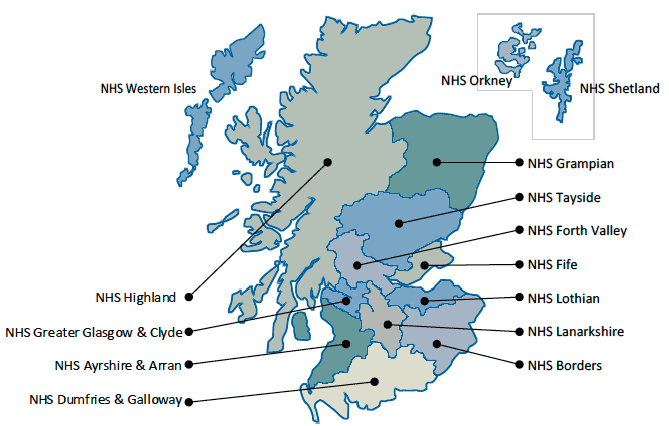
Special NHS Boards |
|
|---|---|
NHS Education for Scotland |
NHS Health Scotland |
NHS National Services Scotland1 |
NHS National Waiting Times Centre (Golden Jubilee) |
Healthcare Improvement Scotland |
NHS 24 |
Scottish Ambulance Service |
The State Hospitals Board for Scotland |
The asset base of NHSScotland is valued at approximately £5 Billion. Most of this value (£4 billion) is associated with land and buildings but other significant fixed assets include vehicles, medical equipment and information management and technology (IM&T).
2.2 The Size and Cost of the Estate
2.2.1 Estate size and distribution
The NHSScotland estate comprises over 4.6 million sq.m of building floor area encompassing over 1,000 buildings / sites ranging in size from 40 sq.m to 200,000 sq.m.
The distribution of this estate across the NHS Boards is shown in the chart below (see Section 2.5 for information on Special NHS Boards):
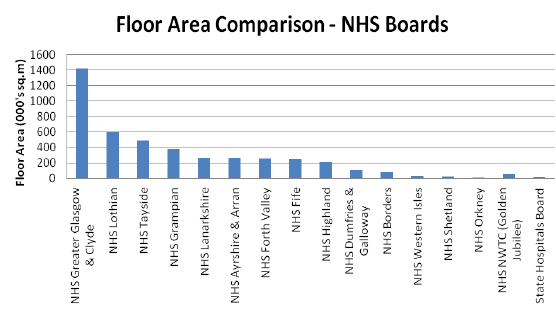
Note: each bar chart included that follows within this section of the report lists NHS Boards in order of the size of their estate, as identified in the above bar chart.
An analysis of the information in the ISD Cost Book 2010 identifies a range of different hospitals / building types as shown in the charts below:
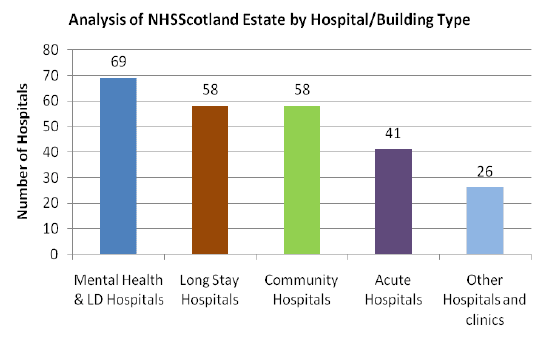
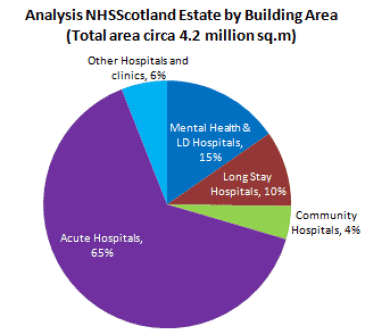
2.2.2 Estate Age and Tenure Profile
NHSScotland occupies approximately 690,000 sq.m (15% of the total) of relatively new / modern accommodation (i.e. less than 10 years old), which has been supported by significant capital investment in property assets over recent years. Investment in NHS assets, including investment in new properties, has more than trebled in cash terms in recent years, from £132.5 million in 2003/04 to £557.4 million in 2010/11 - plus £500m of additional revenue based investment. The following charts show the range of property ages for the NHS Boards and identify that 35% of the estate remains over 50 years old. This does not mean that properties are not functionally suitable but it does indicate that there may be more scope for improvement, further investment or disposal.
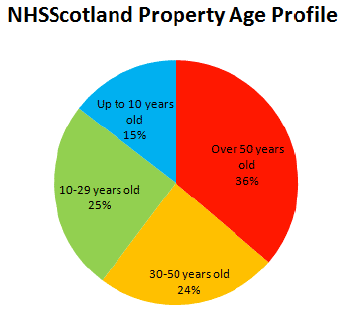
Age profile above includes all 22 NHS Boards
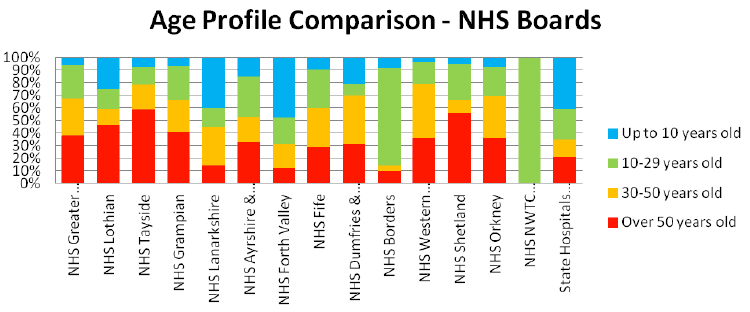
No data available for NHS Highland
The majority of the NHSScotland estate is owned (79%) but for some NHS Boards PPP/PFI and leased property is a significant proportion of their estate, as shown in the three charts that follow.
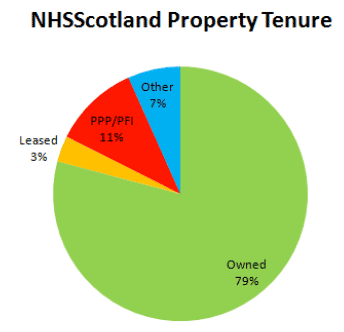
Tenure profile above includes all 22 NHS Boards, where information available
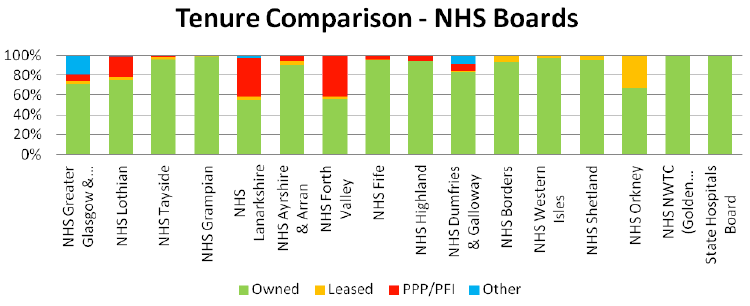
2.2.3 Cost of the Estate
The main direct costs associated with owning and operating the estate (property costs) are:
- Property Maintenance (Pay and Supplies)
- Energy Costs (Heat, Light and Power)
- Rent and Rates
- PFI Costs - Hard Facilities Management.
A breakdown of these Property Costs for the 16 NHS Boards is shown in the table that follows.
| Expenditure 2009/10 £ | ||||
|---|---|---|---|---|
| Pay | Supplies | Total | Percentage of Total | |
| Property Maintenance | 57,324,553 | 55,912,496 | 113,237,049 | 34% |
| Energy | 0 | 68,354,326 | 68,354,326 | 20% |
| Rent & Rates | 0 | 63,935,436 | 63,935,436 | 19% |
| Sub Total Property Costs | 57,324,553 | 188,202,258 | 245,526,811 | 73% |
| PFI Costs - Facilities Management | 91,038,648 | 91,038,648 | 27% | |
| Total | 57,324,553 | 279,240,906 | 336,565,459 | 100% |
(Source: ISD Cost Book 2010)
Analysis of the PFI - Facilities Management Costs in the ISD Cost Book shows that the majority of the £91 million expenditure relates to Acute Hospitals as shown in the table below. Furthermore, over 90% of this expenditure is associated with just 13 Hospitals.
| 2009/10 PFI Expenditure on Facilities Management | ||
|---|---|---|
| £ | Percentage of Total | |
| Acute Hospitals | 60,974,704 | 67% |
| Long Stay Hospitals | 5,015,378 | 5% |
| Mental Health Hospitals | 4,695,454 | 5% |
| Other Miscellaneous | 17,963,069 | 20% |
| Community Hospitals | 2,390,043 | 3% |
| Total | 91,038,648 | 100% |
Interrogation of these PFI costs, undertaken as part of the development of this report, verified that the information submitted to the Cost Book may not have been collated in a consistent way and further work is needed to be confident that these costs represent only the Facilities Management element of the total PFI unitary charge. Furthermore, it is also evident from the interrogation that the various PFI contracts held by NHSScotland provide different ranges of FM services and therefore, the comparison of PFI costs may not be on a "like for like" basis.
2.2.4 Soft Facilities Management Services Costs
It is important not to consider assets in isolation from those Facilities Management services that also support the delivery of high quality healthcare. In addition to the estate costs which are directly associated with owning and occupying the estate there are range of soft facilities management services (Soft FM) services which have a significant impact on the patient environment. Soft FM covers:
- Portering Services
- Catering Services
- Domestic Services
- Transport
- Linen and Laundry Services
- Retail.
The costs associated with these Soft FM services are circa £400 million per annum.
Annex C to this report provides a summary of the service delivery issues and challenges for Soft FM services across NHSScotland. It highlights areas for further investigation which have the potential for improving both the efficiency and quality of service delivery.
2.3 Condition and Performance of the Estate
2.3.1 Physical condition
Analysis of the information contained within each NHS Board's Property & Asset Management Strategy (PAMS) shows that approximately 69% of the NHS Boards estate is in good physical condition (category A or B) but, as shown in the chart below, this can vary significantly across the NHS Boards.
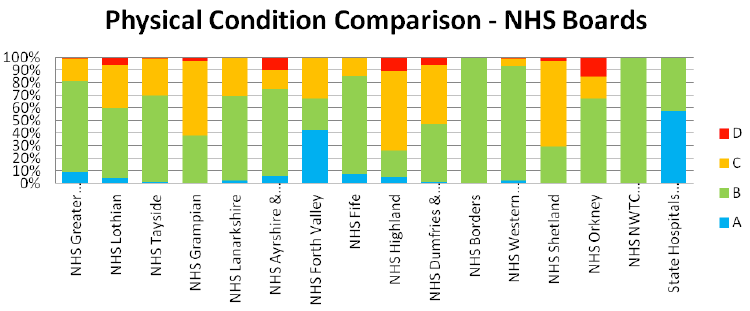
NHS Boards which have buildings assessed as category D - "unsatisfactory" have indicated that they have plans in place to either dispose or replace these buildings over the next 10 years. Hence, the overall amount of buildings in category D is expected to significantly reduce in these NHS Boards.
2.3.2 Backlog maintenance costs
Backlog maintenance costs arise from maintenance that has built up over a number of years and is now giving rise to poor condition and performance. These backlog maintenance costs have been identified as those required to bring the estate back to Condition Ranking B (satisfactory). It is an on-going challenge for the NHS to balance investment between that which is focussed on service improvement and development, and that which is necessary to ensure existing properties do not cause harm or undue disruption to service delivery.
An analysis of the distribution of backlog across NHS Boards is shown in the chart below.
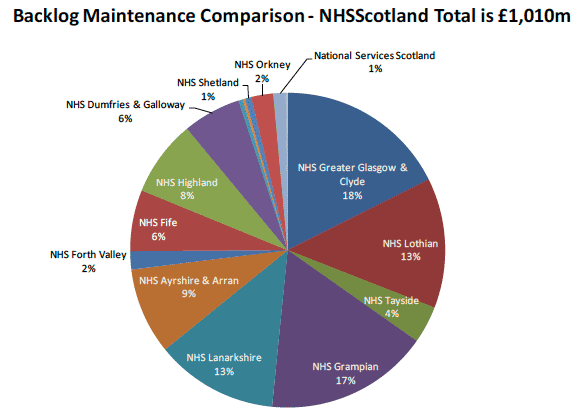
Note: the above chart includes all 22 NHS Boards but those whose backlog is below 1% have not been separately identified for clarity of presentation reasons only.
By the very nature of a mixed use and mixed aged estate, backlog maintenance will always be present in such a large and diverse estate. The emphasis should, therefore, always be on ensuring that the level of backlog maintenance does not unduly increase the risk of building or engineering service failure to an extent that it could have a detrimental impact on each NHS Board's ability to function effectively, efficiently and safely.
NHSScotland managers are focussed on mitigation strategies for the significant backlog maintenance requirement to ensure that high and significant risk backlog is prioritised, based on the risk it poses, for investment within the finite resources made available to them. This is to be reflected in their PAMS with the analysis supported by guidance developed by Health Facilities Scotland to ensure that a common approach is taken across NHSScotland to the assessment of risk.
The two key strategies for reducing backlog maintenance are either to invest directly in the rectification of backlog or to rationalise the estate to remove those properties with high levels of backlog maintenance. For the current stock of modern buildings future backlog can be avoided by ensuring the right levels of expenditure on both operational and cyclical lifecycle maintenance.
The following chart that follows identifies the profile of low, moderate, significant and high risk backlog for each NHS Board.
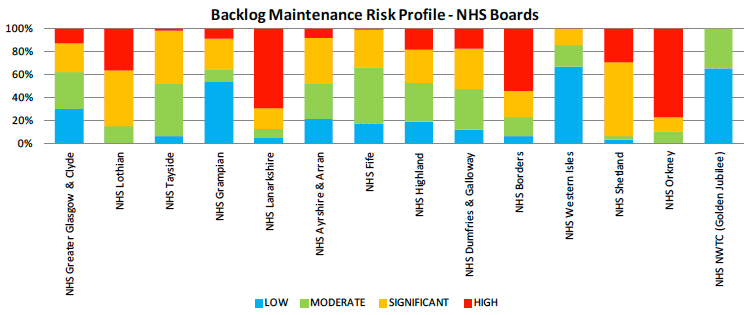
Note: Risk profile not available for NHS Forth Valley and State Hospital
The earlier pie chart expressed the total amount of Backlog Maintenance Cost per NHS Board whereas the following chart shows the average backlog maintenance expenditure requirement per unit of total building floor area for each NHS Board.
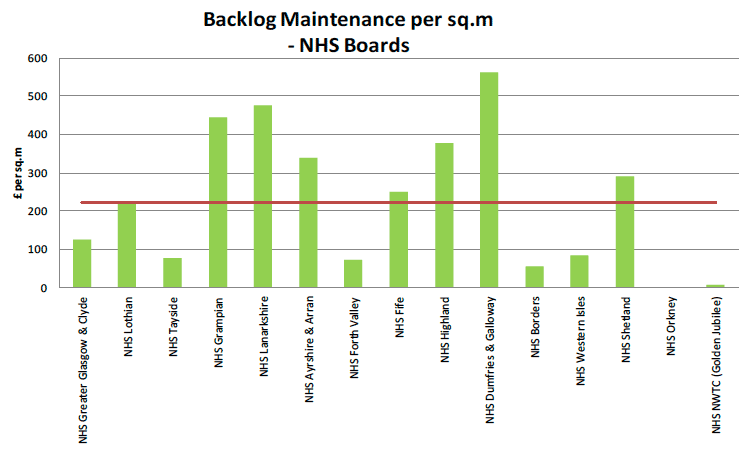
The average backlog expenditure per sq.m shown in the above chart is based on the total building floor area, whereas in practice it can be expected that the majority of backlog will be associated with the areas of poor physical condition (condition C & D). Hence, the backlog cost in a particular area that is in poor physical condition may well be considerably in excess of the average shown in the above chart. However, a number of current projects in hand will have an impact on this figure and include the New South Glasgow Hospitals Project, Royal Victoria Building, the Royal Hospital for Sick Children and the Royal Edinburgh Hospital, Monklands General Hospital, Dumfries and Galloway Royal Infirmary, Victoria Hospital extension in Kirkcaldy and North Ayrshire Community Hospital.
The current backlog maintenance expenditure requirement associated with the existing NHSScotland estate is estimated to be in the region of £1,010 million. However, a significant amount of this backlog cost (£175 million) is in buildings which NHS Boards are planning to dispose of in the next ten years. In addition, of the £2 billion of capital investment over the CSR period the Scottish Government has allocated £300 million targeted on planned maintenance identified in the NHS Boards' Property & Asset Management Strategies. Hence, the combined impact of investment in new facilities, disposals and planned maintenance expenditure will reduce the overall backlog expenditure requirement from £1,010 million to around £535 million. It should also be recognised that around 20% of the current backlog maintenance expenditure requirement is in buildings which are classified as "non-clinical" and will have little impact on the patient's healthcare experience. An analysis of this by NHS Board is shown in the chart below.
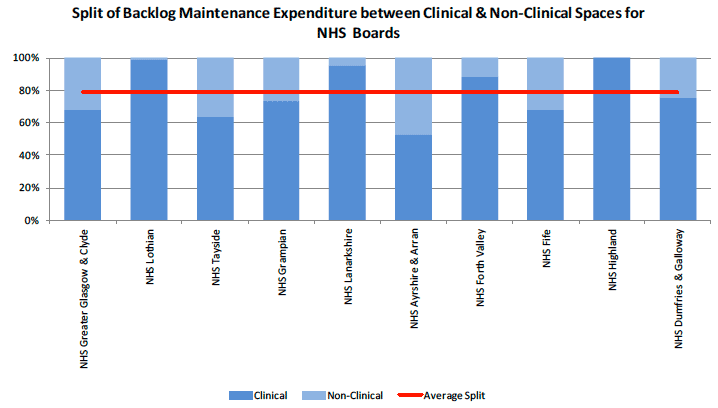
Approximately 40% of the total backlog maintenance expenditure identified is for high or significant risk clinical space. This includes property that has been identified for disposal.
NHS Boards are already targeting high and significant risk clinical back log maintenance through planned maintenance and re-provision plans outlined in their PAMS. Overall, Scottish Government budgeting levels should be sufficient to reduce existing high and significant clinical backlog maintenance levels for retained property to manageable levels over the next five years.
For lower risk backlog maintenance and non clinical space, Scottish Government will work with NHS Boards to develop detailed long term plans for rationalisation and disposal of surplus, unsuitable, poor quality properties, and life cycle planned maintenance plans for retained property. These will be updated annually as part of the PAMS update and reviewed more formally through the LDP process.
2.3.3 Space utilisation & functional suitability
Accommodation space has a direct relationship with cost. The more space that is provided the more ownership and occupancy related costs will be incurred. The aim, therefore, is to hold only that space which is needed to support the delivery and support of effective and efficient service delivery. Under utilisation of space incurs wasted financial resources, whereas under provision of space can result in ineffective and/or inefficient working practices and poor clinical outcomes.
The following chart shows the proportion of each NHS Board's estate that is reported through their PAMS as being fully utilised. However, recent discussions with NHS Boards on these results suggest inconsistencies in the definitions and categorisation of space use and a general lack of consistency in collation of space utilisation data. Experience based on other UK studies indicates potential low utilisation rates in Operating Theatres and the Primary Care estate, which suggests that the currently reported information may be somewhat optimistic. In view of these issues, the graphs should at this stage be recognised as only providing a broad indication of space utilisation across NHS Boards and that future improvements in the appraisal of space utilisation may result in adjustments to these figures in subsequent years.
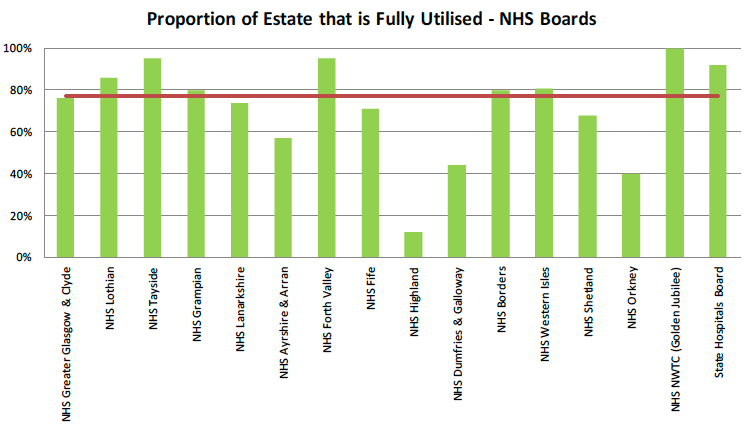
The chart below shows, in comparison with full utilisation, the proportion of the estate that is reported as empty, under used and overcrowded.
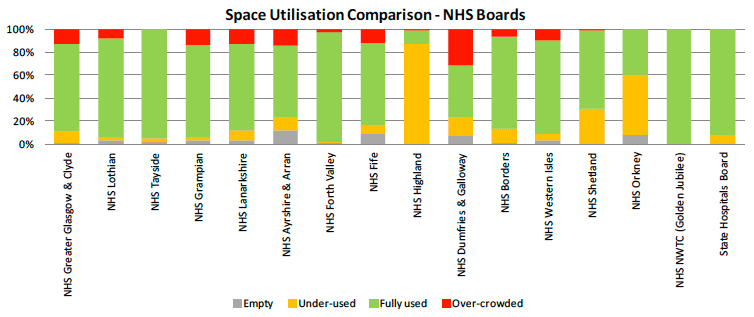
The under utilisation of accommodation across NHS Highland reflects the challenges faced from such a geographically diverse area and the need to maintain and provide critical healthcare facilities in locations with relatively low population masses
The estate also plays an important role in supporting the effective and efficient delivery of services. Poor functional suitability often results in inefficient working practices, increased staffing levels and poor clinical outcomes. Therefore, it is an important component of the organisation's overall performance. The proportion of the estate reported by NHS Boards as being functionally suitable (category A or B) is shown in the following chart.
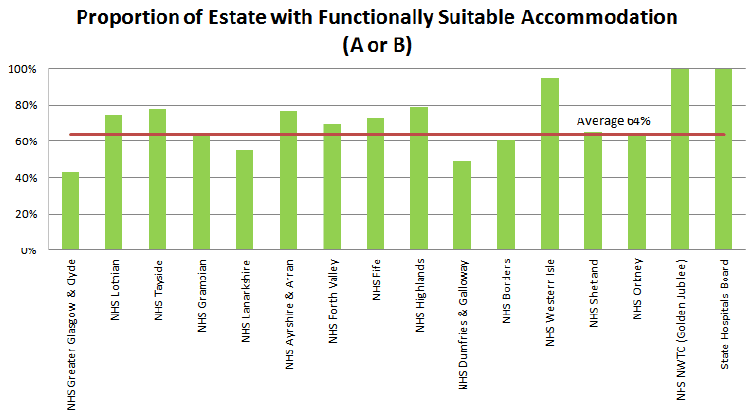
The chart above indicates a relatively good level of performance since it shows that approximately 64% of accommodation is reported as functionally suitable. However, as with the space utilisation data there is some concern that there are inconsistencies in the way in which NHS Boards are currently undertaking assessments of functional suitability.
NHS Boards are currently reviewing their data and performance on space utilisation and functional suitability as part of the PAMS development process.
2.4 Patient Satisfaction Survey results relevant to premises
Better Together is Scotland's patient experience programme, using the public's experiences of NHSScotland to improve health services. One of the key elements it is currently focussed on is the Inpatients Patient Experience Survey 2010. This asked a range of questions about people's experiences of staying overnight in a Scottish hospital during 2008/09 and included a particular question that was relevant to the condition and performance of the hospital estate, namely "Q.13 Overall, how would you rate the hospital environment?" The following table shows the results of the response to this question set against different hospital types:
| NHS Board | Excellent or Good % | Fair % |
Poor or Very Poor % |
|---|---|---|---|
| A1 - Teaching hospitals | 78% | 18% | 5% |
| A2 - Large general hospitals | 77% | 19% | 4% |
| A3 - General hospitals | 89% | 9% | 2% |
| B - Long stay hospitals | 80% | 16% | 4% |
| J26 - Community Hospitals | 89% | 9% | 2% |
| Scotland | 78% | 17% | 4% |
The results are generally positive across all hospital types but with General and Community Hospitals producing the slightly better results. However, it needs to be recognised that these results are based on only one question and, therefore, should not be taken as indicating overall patient satisfaction in NHSS premises. An enhanced question set, therefore, needs to be developed for improved assessment of patient and public opinion.
The same Patient Experience question can also be used to compare results across each of the different NHS Boards and the following chart presents the level of positive responses for each NHS Board. It should be noted that the Forth Valley (FV) and NHS Fife scores relate to the situation prior to the opening of the new Forth Valley Royal Hospital and the new build at the Victoria Hospital in Kirkcaldy.
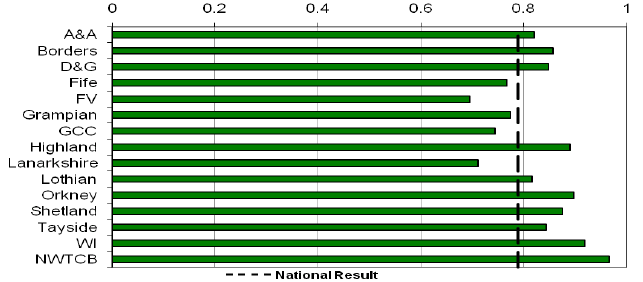
The scale is 1 = 100% positive responses.
2.5 Special NHS Boards
2.5.1. The Special NHS Board's Estate
There are six Special NHS Boards not included in the previous analysis, and these are:
- National Services Scotland
- NHS Education for Scotland
- Healthcare Improvement Scotland.
- NHS Health Scotland.
- NHS24
- Scottish Ambulance Service.
Together, their combined estate accounts for almost 150,000 sq.m of accommodation, as shown in the chart that follows - this excludes NHS24 whose data is currently not available.
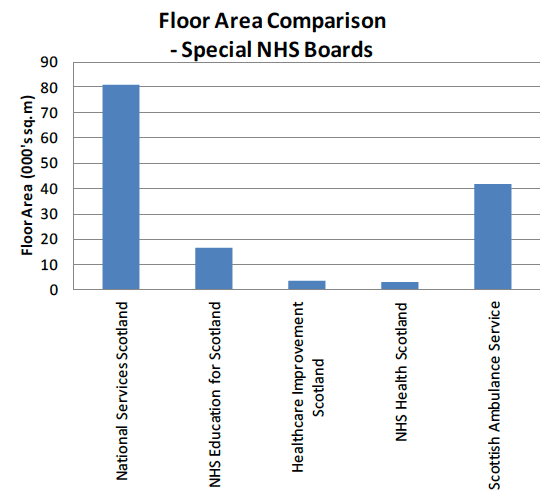
The physical condition of these properties is similar to that of the NHS Boards, with 62% in good physical condition (category A or B), as shown in the chart below:
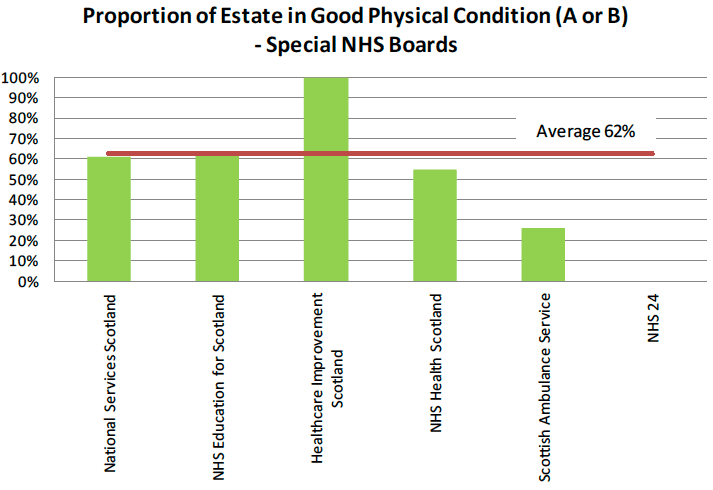
2.5.2. Special NHS Boards - Office Accommodation
Any examination of the NHSScotland estate needs to recognise that much of the property occupied by the Special NHS Boards is office accommodation which is quite different in form and functionality from the majority of the accommodation occupied by the NHS Boards. An example of this is the tenure status of occupied accommodation where there is much greater use of leased accommodation.
All Special NHS Boards recognise the importance of rationalising their estate to maximise efficiency and reduce the number of Special NHS Board properties. Special NHS Boards are currently focusing on maximising the utilisation of Meridian Court in Glasgow and Gyle Square in Edinburgh which will have a significant impact on the overall amount of leased properties held.
Whilst these Special NHS Boards are an essential and integral part of NHSScotland, their office estate has more in common with the wider civil and government estate that is occupied by government departments and agencies. This very large public sector office estate also has much in common with the extensive office estate that is occupied by a wide range of private sector bodies and organisations.
There are benchmarking schemes in use for the mainly office based Central Government and Civil Estate. The primary indicators used to report and assess building efficiency these benchmarking schemes are:
- Cost per full time equivalent employee (FTE) - expressed as £/FTE
- Cost of space - £/sq.m
- Space efficiency - sq.m/FTE
At the current time, the Special NHS Boards are not participants in this benchmarking scheme and nor do they have their own scheme. Work on the development of this State of the Estate Report has shown that much of the information needed to benchmark performance and efficiency in their office accommodation is collected but not currently in a consistent way that would enable benchmarking across the Special NHS Boards to be undertaken. However, it should be possible to co-ordinate the information currently collected across the Special NHS Boards and to make changes that would enable benchmarking of office accommodation to be undertaken. Hence, it is expected that future versions of this report will include results from benchmarking of office accommodation across the Special NHS Boards.
Over recent years the Special NHS Boards have made significant progress on introducing new ways of working, flexible working and workplace redesign. In particular, NHS National Services Scotland (NSS) has done extensive measurement of space efficiency and costs across its own large and diverse office estate as part of implementing its Property Strategy which is focused on:
- Providing well designed and efficient space which is flexible towards embracing changing working practices and new technology
- Maximising the opportunity for staff to develop and deploy their knowledge, skills and personal qualities creatively to add value to the business and services
- Achieving synergies from shared use of accommodation & support services
It should also be noted that within their total estate the NHS Boards also have significant amounts of office accommodation which benefit from similar best practice arrangements as those in Special NHS Boards. Work is in hand with a number of NHS Boards to further review their office accommodation in line with the UK Government standard benchmarks for office accommodation.
Contact
Email: James H White
There is a problem
Thanks for your feedback